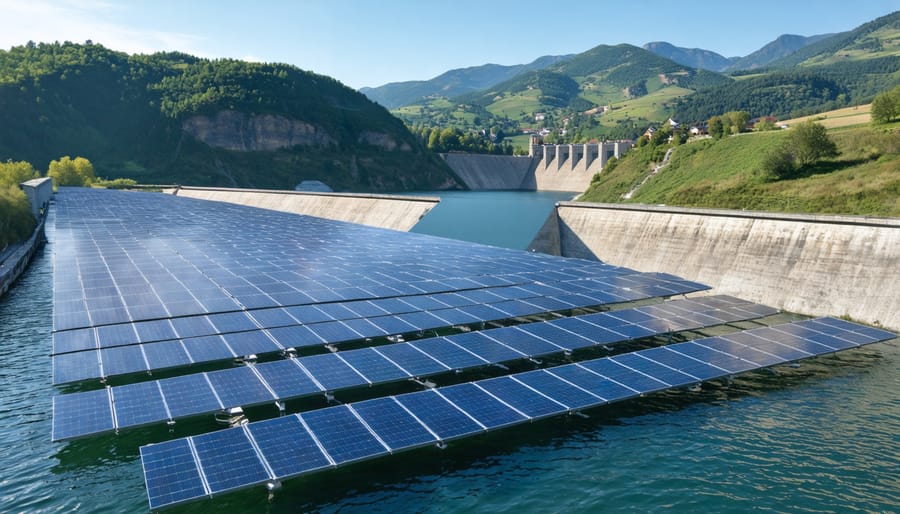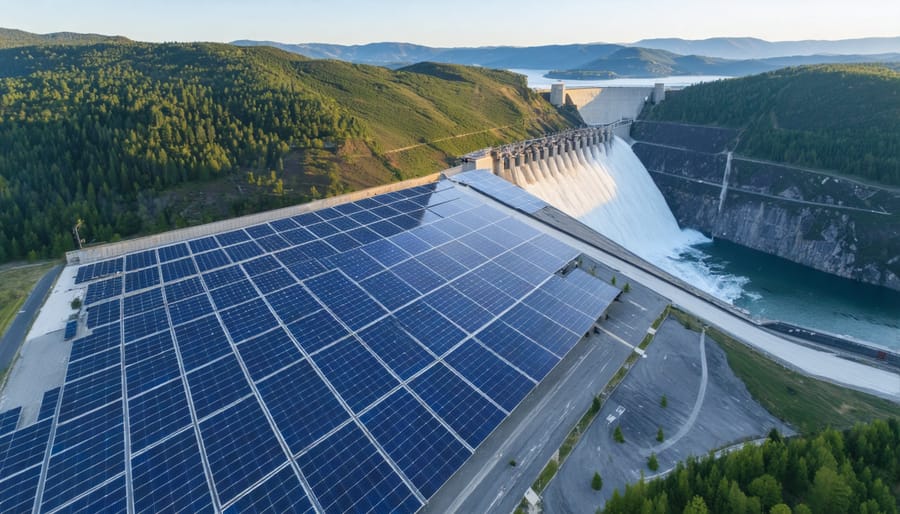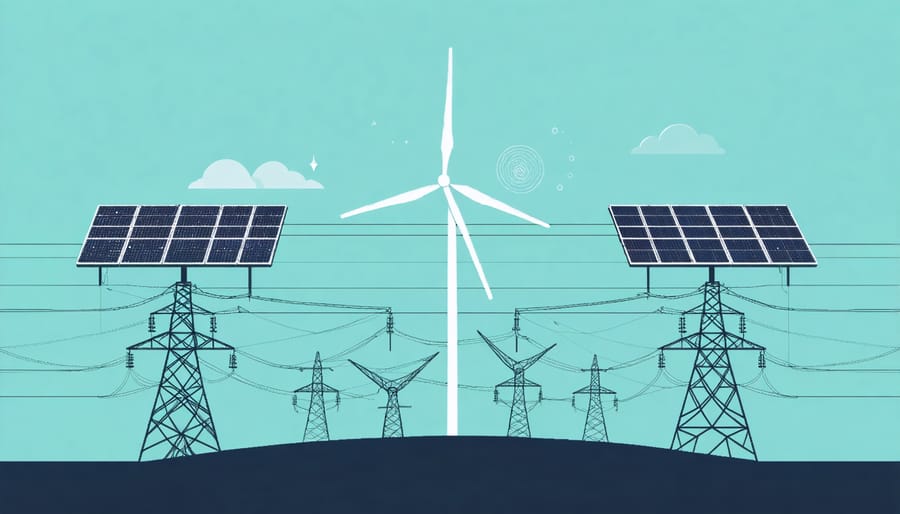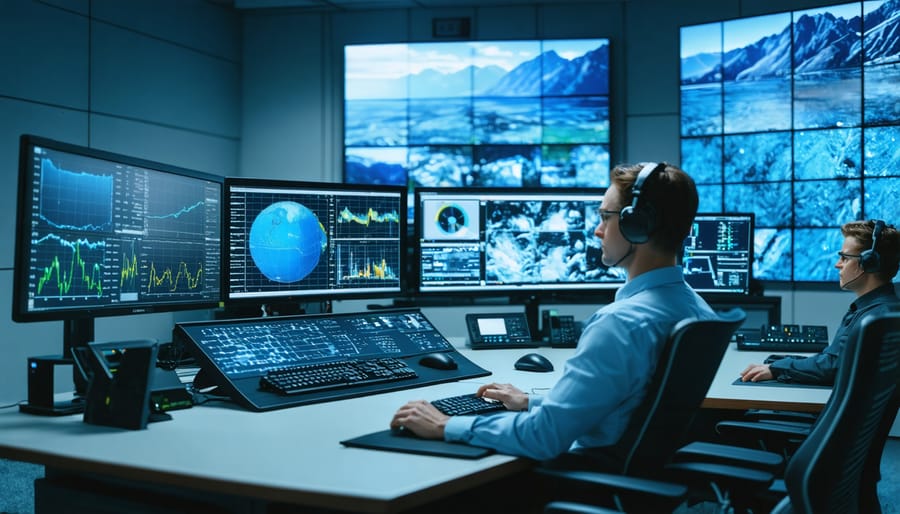Hydro Solar: How This Powerful Energy Hybrid Is Transforming European Power

The fusion of hydroelectric and hybrid solar systems represents one of Europe’s most promising renewable energy breakthroughs, offering unprecedented potential for sustainable power generation. By harnessing both water and solar resources simultaneously, these integrated systems achieve up to 85% higher efficiency than standalone installations while requiring 30% less land area. For regions across Europe experiencing variable weather patterns, this dual-technology approach ensures consistent power output through complementary generation methods – solar panels produce maximum energy during clear daytime hours, while hydroelectric components maintain supply during nights and overcast periods. The technology’s rapid advancement has already enabled successful implementations across Alpine regions, demonstrating how strategic placement of floating solar arrays on existing hydroelectric reservoirs can transform traditional power infrastructure into cutting-edge clean energy hubs. This innovative combination not only maximizes energy yield but also addresses crucial environmental concerns, reducing water evaporation by up to 70% while providing clean power to thousands of European homes and businesses.
Understanding Hydro Solar Integration

The Complementary Nature of Water and Sun
Water and solar energy form a natural partnership in renewable power generation, each compensating for the other’s limitations. While solar panels generate electricity during sunny days, hydroelectric systems can maintain consistent power output regardless of weather conditions or time of day. This complementary relationship creates a more reliable and stable energy supply throughout the year.
During peak sunlight hours, solar systems can operate at maximum efficiency while allowing reservoirs to conserve water resources. Conversely, when solar production decreases during cloudy periods or at night, hydroelectric systems can rapidly adjust their output to meet energy demands. This dynamic interplay helps maintain grid stability and ensures continuous power supply.
The seasonal variations of both sources also work in harmony. In many European regions, periods of higher rainfall and lower solar radiation during winter months are balanced by increased solar production and lower precipitation during summer. This natural offset helps create a more predictable and sustainable energy generation pattern throughout the year, making hydro-solar hybrid systems particularly attractive for large-scale renewable energy implementation.
Key Components of Integrated Systems
A well-designed hydro solar system integrates several critical components that work in harmony to maximize energy production and efficiency. The primary elements include photovoltaic (PV) panels, specifically engineered for optimal performance in varying European climate conditions, and hydroelectric turbines that convert water flow into electrical power.
The system’s backbone consists of advanced inverters that convert DC power from both solar panels and hydro turbines into grid-compatible AC electricity. Smart control systems monitor and regulate power flow, ensuring seamless integration between solar and hydro generation. Energy storage solutions, typically comprising high-capacity batteries or pumped storage facilities, help balance supply and demand.
Essential infrastructure also includes robust mounting systems for solar arrays, water intake structures, and specially designed pipelines for hydroelectric components. Modern monitoring equipment provides real-time performance data, while grid connection infrastructure enables power export and import as needed.
Water management systems, including flow regulators and filtration units, maintain optimal operation of the hydro components while protecting local ecosystems. Together, these elements create a reliable, sustainable power generation system that maximizes the benefits of both solar and hydroelectric technologies.
Benefits for European Energy Markets
Enhanced Grid Reliability
The combination of hydroelectric and solar power systems creates a remarkably robust and reliable energy infrastructure. While solar panels generate electricity during daylight hours, hydroelectric facilities can quickly adjust their output to maintain consistent power supply, addressing one of the primary challenges in renewable energy: intermittency. This synergy significantly enhances grid stability and integration, particularly in regions with varying seasonal conditions.
During peak solar production, excess energy can be used to pump water to higher reservoirs, effectively storing energy for later use. This stored potential energy can then be released through hydroelectric turbines during periods of low solar generation or high demand, creating a natural battery system. The complementary nature of these technologies proves especially valuable in European countries where seasonal variations significantly impact solar production.
Modern smart grid systems can automatically balance the output between hydro and solar sources, optimising energy distribution based on real-time demand and generation capacity. This intelligent management ensures consistent power delivery while maximising the use of renewable resources. The result is a more resilient energy network that can maintain stable output despite weather changes or temporary disruptions, providing reliable power for both industrial operations and residential needs.

Cost Efficiency and ROI
Investing in hydro solar energy systems presents compelling financial advantages for European property owners and businesses. While initial installation costs may seem substantial, ranging from €15,000 to €50,000 depending on system size and complexity, the long-term economic benefits significantly outweigh the upfront investment.
Most hybrid hydro solar installations achieve complete return on investment within 6-8 years, thanks to reduced utility bills and various EU-backed incentives. Property owners typically experience 60-80% reduction in energy costs, with some systems generating surplus power that can be sold back to the grid, creating an additional revenue stream.
The durability of these systems further enhances their cost-effectiveness. Solar panels generally last 25-30 years, while hydroelectric components can function efficiently for 35-40 years with proper maintenance. This extended lifespan, combined with minimal operational costs, results in decades of reliable, low-cost energy production.
European Union incentives make the investment even more attractive. Many countries offer tax rebates, grants, and feed-in tariffs specifically for hybrid renewable energy systems. For instance, property owners can access funding covering up to 40% of installation costs through various national renewable energy programmes.
Maintenance costs remain remarkably low, typically requiring only annual inspections and occasional component replacement, averaging €200-300 per year. This predictable expense structure makes hydro solar systems particularly appealing for long-term energy planning and budgeting.
Implementation Strategies
Planning and Assessment
Successful implementation of a hydro solar energy system begins with thorough site assessment and careful planning. The first step involves evaluating your location’s solar exposure patterns throughout the year, considering factors such as latitude, local weather conditions, and potential shading from nearby structures or vegetation.
For the hydroelectric component, assess your property’s water resources, including available flow rates, head height (vertical drop), and seasonal variations. Professional surveyors can help determine these crucial measurements and identify optimal positioning for both solar panels and hydro installations.
A comprehensive resource assessment should include:
– Annual solar radiation levels
– Water flow measurements across seasons
– Available land area for solar arrays
– Existing infrastructure compatibility
– Grid connection possibilities
– Environmental impact considerations
It’s essential to engage with local authorities early in the planning phase to understand permit requirements and environmental regulations. Many European regions have specific guidelines for water usage and solar installations that must be considered during the planning stage.
Consider working with certified renewable energy consultants who can conduct detailed feasibility studies and help optimize system design. They can provide accurate energy yield predictions and financial projections based on your specific site conditions and energy needs.
Documentation of all site characteristics, including topographical surveys and hydrological data, will form the foundation of your project plan and help secure necessary approvals and potential funding opportunities.
Technical Integration
The integration of hydro-solar systems requires careful planning and precise implementation to ensure optimal performance. The process typically begins with a comprehensive site assessment to determine the ideal placement of solar panels and evaluate existing hydroelectric infrastructure. Key components include hybrid inverters, which manage power flow from both sources, and sophisticated energy management systems that optimize resource utilization.
Installation teams must coordinate the connection of solar arrays with existing hydroelectric systems through a central control unit. This unit synchronizes power generation from both sources, managing load distribution and storage capabilities. The integration process typically involves:
1. Installing bi-directional meters to monitor energy flow
2. Implementing smart controllers for automated switching between sources
3. Setting up backup systems for continuous operation
4. Configuring power quality monitoring equipment
5. Installing safety disconnects and protection devices
Modern hydro-solar installations often incorporate cloud-based monitoring platforms, allowing operators to track performance metrics in real-time and adjust settings remotely. The system’s modular design enables future expansions and upgrades, ensuring long-term scalability for growing energy needs.
European standards require specific safety protocols and grid connection requirements, which must be carefully considered during the integration process. Professional certification and regular maintenance schedules are essential for maintaining system efficiency and compliance with regional regulations.

Maintenance and Optimization
Regular maintenance and optimization are crucial for maximizing the efficiency of hybrid hydro-solar systems. A well-maintained system can operate at peak performance for 20-25 years, delivering optimal energy yields throughout its lifecycle.
For solar components, quarterly cleaning of photovoltaic panels helps prevent dust and debris accumulation that can reduce efficiency by up to 15%. In regions with heavy rainfall or snowfall, more frequent inspections may be necessary. Annual electrical connection checks and thermal imaging surveys can identify potential hotspots or connection issues before they become problematic.
The hydroelectric components require monthly inspections of turbines, generators, and water flow systems. Sediment build-up should be monitored and cleared regularly to maintain optimal water flow. Bearing lubrication and mechanical component checks should be performed according to manufacturer specifications, typically every six months.
Performance monitoring systems play a vital role in optimization. Modern smart monitoring solutions can track energy production patterns, weather impacts, and system efficiency in real-time. This data helps identify performance drops and maintenance needs before they affect output significantly.
For European installations, it’s recommended to schedule major maintenance during shoulder seasons (spring or autumn) when energy demand is typically lower. Professional maintenance contracts often include performance guarantees and regular optimization assessments, ensuring your system maintains its efficiency throughout its operational life.
Remember to maintain detailed maintenance logs and performance records, as these are valuable for warranty claims and system optimization strategies.
Future Developments
Innovation on the Horizon
The future of hydro solar technology is poised for remarkable advancement, with several groundbreaking innovations on the horizon. European researchers are developing new floating solar panels with enhanced tracking systems that optimize both water conservation and energy generation. These next-generation systems are designed to complement existing hydroelectric infrastructure, creating more efficient renewable energy integration solutions.
Emerging technologies include smart hybrid control systems that automatically balance power output between hydro and solar sources based on real-time weather conditions and energy demand. Advanced materials science is also yielding more durable, water-resistant solar panels specifically designed for floating applications, with projected lifespans exceeding 30 years.
Perhaps most exciting is the development of AI-driven predictive maintenance systems that can anticipate potential issues before they occur, ensuring maximum system uptime. Combined with new energy storage solutions tailored for hybrid systems, these innovations promise to make hydro solar installations more reliable and cost-effective than ever before.
European Policy Support
The European Union has established robust support mechanisms for hydro solar energy projects through various policy frameworks and financial incentives. The Renewable Energy Directive (RED II) sets ambitious targets for renewable energy adoption, with specific provisions for hybrid systems like hydro solar installations. Member states offer feed-in tariffs, premium payments, and investment grants that make these projects more financially viable.
Notable initiatives include the Innovation Fund, which provides substantial funding for innovative clean energy projects, and the European Regional Development Fund (ERDF), supporting regional implementation of renewable energy solutions. Countries like Spain, Portugal, and Austria have introduced specific legislation to streamline permitting processes for hybrid installations, while offering tax benefits for businesses investing in hydro solar technology.
The European Investment Bank provides preferential loans for large-scale hydro solar projects, particularly those demonstrating high efficiency and environmental sustainability. Additionally, the EU’s Green Deal framework ensures long-term policy stability, making hydro solar investments more secure and attractive for both private and public sector stakeholders.
The integration of hydroelectric and solar power systems represents a significant step forward in renewable energy development across Europe. This hybrid approach offers compelling advantages, combining the reliability of hydroelectric power with the scalability and accessibility of solar technology. As we’ve explored, hydro solar solutions provide enhanced grid stability, reduced environmental impact, and improved energy security for communities and businesses alike.
The future outlook for hydro solar energy in Europe appears particularly promising. With advancing technology and decreasing installation costs, these hybrid systems are becoming increasingly viable for both large-scale utilities and smaller installations. The European Union’s commitment to achieving carbon neutrality by 2050 further strengthens the case for expanded adoption of hydro solar solutions.
Key market trends suggest continued growth in this sector, with innovations in energy storage, smart grid integration, and improved efficiency driving development. For property owners and businesses considering renewable energy investments, hydro solar systems offer a robust and future-proof solution that aligns with both environmental responsibilities and economic interests.
As we move forward, the success of hydro solar energy will depend on continued technological advancement, supportive policy frameworks, and growing public awareness. With proper planning and implementation, these hybrid systems can play a crucial role in Europe’s sustainable energy future, offering reliable, clean power while supporting the transition to a more resilient and environmentally conscious energy landscape.
Leave a Reply